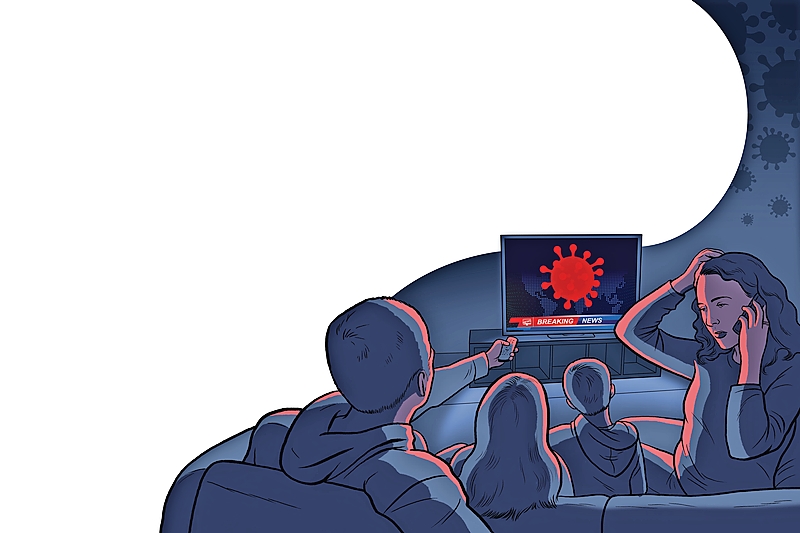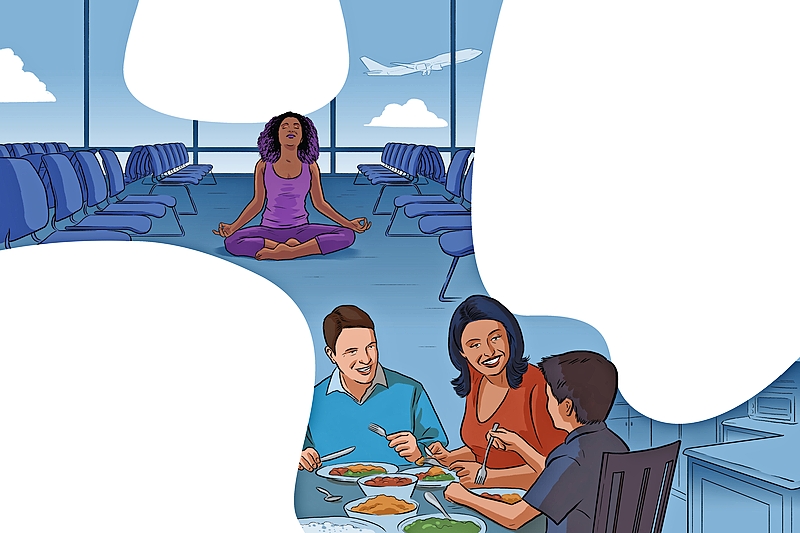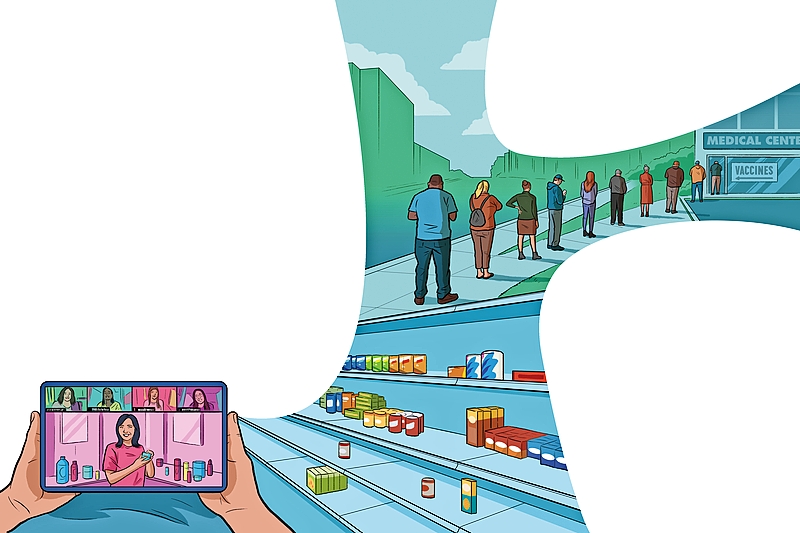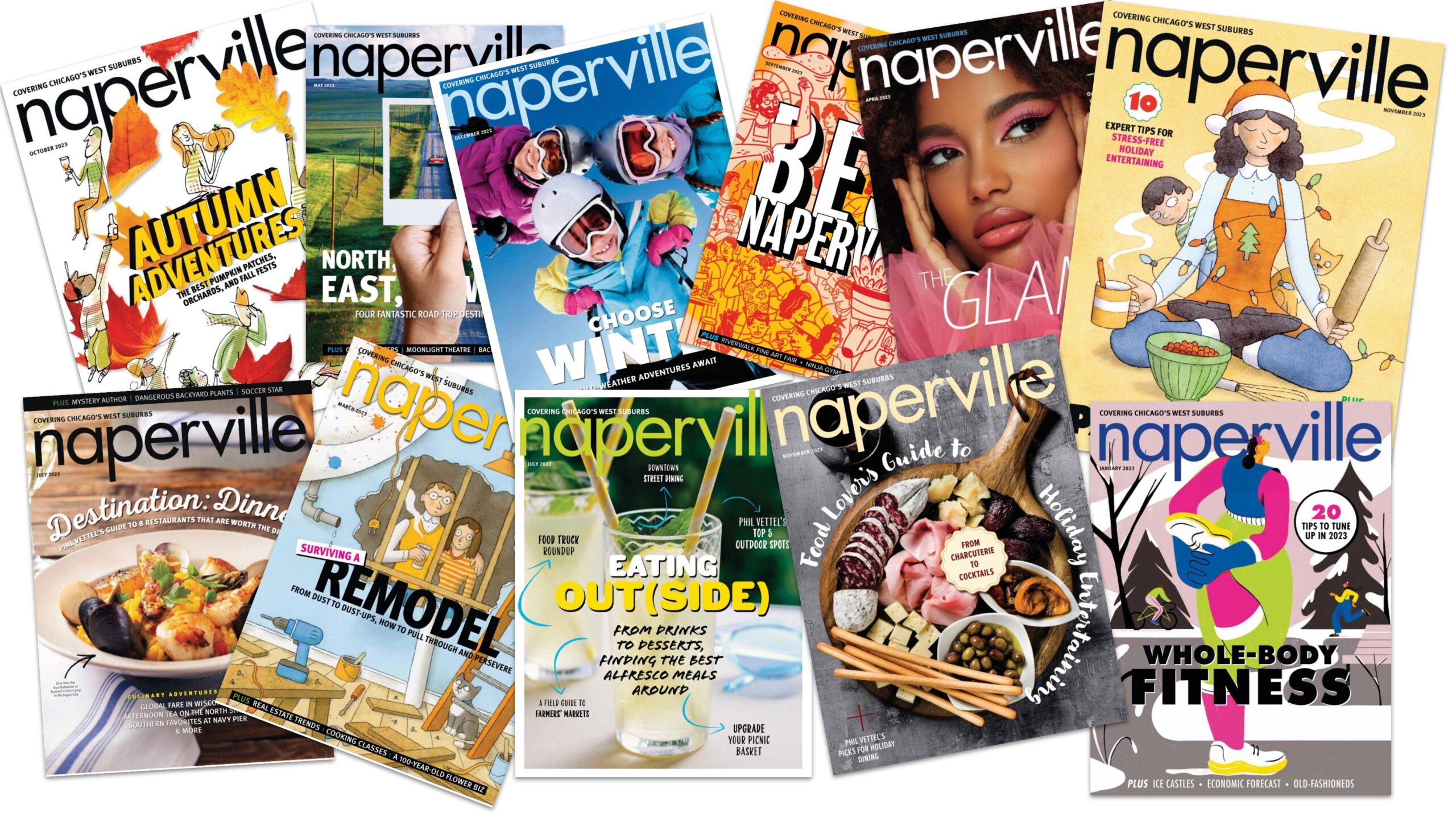The Journal of our COVID Year
By Naperville Magazine
January 2021 View more Featured

It’s safe to say that 2020 was a year like no other. Due to SARS-CoV-2, life within our communities has been irrevocably altered in ways that no one could have anticipated. Some have undoubtedly experienced profound losses, which no vaccine or treatment will ever be able to replace. But amid the pain, some smaller triumphs have taken root. We spoke to local families and experts in the hopes of cataloging some of those stories—the good, the bad, and the unknown future—so that we might look back, years from now, with a greater understanding of what we’ve lost, as well as what we might have gained.
Story By Peter Gianopulos
Illustrations by Rob Dobi

Rediscovering Solitude
The leaves were as red as Spanish sangria and raspberry jam. Some were colored orange, like tiger fur and fluttering marigold petals. Others backlit green, like lime-colored neon. That’s what Dina Kosiba relished most about her solitary bike rides and runs this fall: the colors, the motion, the solitude. The act of seeing familiar things anew.
“I don’t know if the foliage ever looked as beautiful as it did this year,” says Kosiba, a Bolingbrook-based interior designer. “Maybe I just never paid enough attention.”
She wonders whether sequestration is giving us newfound perspectives on our homes. Rooms stuffed with stuff, like cluttered Victorian drawing rooms: untrending. Building private spaces—more interior walls, please—to work, and meditate, and be alone: a renaissance. “I think we’re relearning the importance of self-care through our homes,” she says.
Consider window treatments: curtains, shades, blinds—all declining. The goal? Invite the outside in. There’s also an uptick in colors that marry well with Mother Nature’s natural wardrobe. Terra cottas. And all sorts of greens: emeralds, olives, absinthes.
“I think we’ve begun to realize that our homes can be a refuge,” says Kosiba. “Not a place we have to leave, but a place we can feel good in. A place filled with warmth and calm.”
Suburban Downtowns 2.0
Reba Osborne of the Naperville Chamber of Commerce says increased remote work opportunities will certainly reshape suburban communities. On the one hand, it may redistribute dollars spent downtown to local businesses and lead to a suburban housing boom. But early indications also show that large companies—like Amazon—are gobbling up brick-and-mortar spaces, while family-run businesses are eager to downgrade to smaller footprints in hopes of strengthening their online business models. Call it the Great Rebalancing.
The Second Surge
When the first COVID-19 surge hit last March, dense urban areas seemed to absorb the brunt of the virus rather than many suburban communities. Dr. Steve Lowenthal, the senior VP of medical affairs and chief medical officer for Rush Copley Medical Center in Aurora, says the recent surge was not only more “location agnostic,” but seems to be affecting more health care workers. Given that hospitals are still dealing with so-called long-haulers—patients who’ve shed their COVID viral loads but continue to experience extreme fatigue and other side effects—is a reminder that long-term effects are still unknown.
Refocusing on Mental Health
A recent study found that one in every five people with COVID-19 is being diagnosed with psychiatric issues—e.g., insomnia and depression—
after contracting the virus.
Patricia Fairbanks, chief nursing officer at Linden Oaks Hospital, says these findings present a unique opportunity to destigmatize and better address the importance of treating mental health issues.
The Kids Might Be All Right
For a few surreal weeks in May, Ginny Jackson and her husband, Ken, welcomed all five of their teenage and 20-something children back to their Naperville home.
It felt like one extended snow day. Chaos, meet angst. Jobs had been lost, privacy squashed, autonomy sacrificed. But when Ginny established a card night—playing Five Crowns, a gin rummy variant—something magical happened. After every hand, somebody would gin up old family stories.
Grade-school triumphs. Blush-worthy family blunders. Vacation mishaps worthy of a Clark Griswold movie. Night after night, everyone seemed to reclaim something they assumed they’d lost. For the kids: new side hustles and fresh career directions. For Ginny and Ken? Two things. No. 1: the bittersweet realization this might be one of the last extended periods when they’d all be together. And No. 2: the conviction that their kids—and hopefully all of our kids—will be all right after this particular “blizzard” blows through.

A Small Business Apocalypse
Remember the local restaurant that sponsored your children’s basketball team? The bookseller who introduced you to your favorite author? The boutique that bailed you out last Valentine’s Day? Know this: Many are a knife’s edge away from closing forever.
“It’s been absolutely heartbreaking to see what’s happening to local small businesses,” says Reba Osborne, director of government affairs for the Naperville Chamber of Commerce.
The pandemic has ushered in a devastating kaleidoscope of shifting rules, regulations, and shutdowns, which have bred uncertainty and questions.
Should a family-run shoe store or frame shop be shuttered, while a nearby big box store selling shoes and frames stays open? Can any independent restaurant endure continued indoor dining limits? How can a business in one county remain open, while another, blocks away, be forced to close?
Consider, says Osborne, the devastating ripple effects. Fewer restaurants equals reduced foot traffic. Less traffic produces business closures. Fewer businesses, smaller tax revenues. Less revenue, fewer festivals. Less outside traffic equals steeper problems for everyone.
A dark winter cometh, unless we—residents, shoppers, politicians, and regulators alike—find ways to become better neighbors. “DuPage County opened up a grant to businesses [in October],” says Osborne. “Within two hours, we were overrun with applications. It shows how desperately local businesses need our help.”
Family Vacations Like No Other
COVID and Sanibel, Florida, will forever be intertwined for Brian James and his family of six. A sojourn like no other: Zero airport waiting. Nearly empty planes. And the beach. The six of them practically owned the place. The sand, surf, and sunrises all reserved for their toes and eyes only. “It will go down,” says the Naperville resident, “as one of the most memorable vacations of our lives.”
The Ties That Unbind
In the 25-plus years Jeff Lucas has been a licensed clinical professional counselor, he’s never seen a more dramatic surge in relationship rifts and family struggles. It’s been, he says, a perfect storm of stress, anxiety, depression, and fear coupled with fewer opportunities for avoidance or escape. His practice, Durham Counseling in Naperville, offers both high-tech and low-tech solutions, but he can also recommend a DIY at-home shortcut:
Close your eyes and focus on the positives in the present moment, rather than the uncertainties of tomorrow. Break mindfulness into four levels—physical, emotional, mental, spiritual—and address each. Maintain a good diet and sleep schedule. Perform deep breathing exercises or listen to music. Walk or play outdoor sports. Pray and meditate. “If you can find positive thoughts and hold onto them for just five seconds,” he says, “you can actually rewire your brain.”
Gird for the Not-So-New Normal
“When people say the world is going to return to normal, no one knows what that new normal will look like,” says Karen Wolownik Albert, the CEO of Recovery Centers of America at St. Charles. “I think we need to be on guard against some sense of disappointment—and new challenges—even after the vaccine.”
Reclaiming the Dinner Table
Some mornings, Jaime Peebles marvels at all the white space on his travel calendar.
The cloud solutions architect used to live in the clouds, traveling 100 days a year—minimum. Airplanes. Ubers. Freeways. Trains. Hotels. Airport buses. More planes. It was the corporate version of a Richard Scarry illustration. Now his daily commute involves descending stairs to his basement office in Naperville, then jogging back upstairs to cook. Every day. “No one in my house wants me making cupcakes,” he says, “but if it involves charcoal, it’s my responsibility.”
Now, the family’s dinner table is worthy of Cook’s Illustrated. Jiggly briskets of beef parka’d with pepper. Marbled pork shoulders so rich and tender you salivate just looking at them. Proteins, proteins everywhere. Seared. Smoked. Sizzled. Caramelized. ’Cued. Crisped.
Working to help bring home the family bacon, says Peebles, is nice. But being able to cook it and enjoy it as a family? That tastes twice as nice.

Rise of Virtual Entertainment
Turns out, we all yearn for shared distractions. That was Holly Stacey’s recent mini epiphany. Not disembodied voices on a phone. Not Instagram snapshots. Not Netflix reruns. No. No. No. Live, unscripted human contact. That, she realized, was natural medicine.
Although Stacey currently works as a medical receptionist, she is a born actress and entertainer. Which is why, this past summer, she began throwing virtual Facebook and Zoom parties on behalf of Arbonne International, a beauty care line.
All she needed was 15 minutes. She’d invite perfect strangers into video chatrooms and use musical parodies to introduce products. Sitting at her home piano, she’d rejigger Dolly Parton’s “9 to 5” to describe ready-made makeup sets and perform funny riffs on “Stay Awake” from Mary Poppins for sleep-well bundles.
“We all need a break from reality,” she says, “but sometimes it helps to share that break with others.” That’s the silver lining to our new gig-driven economy. If you’re an artistic soul, you have new means of sharing your talents. Virtual concerts. Singing telegram services. Parking lot theatrical productions. Online catalogs filled with hand-sewn treasures.
It’s more proof, Stacey suggests, that artistry doesn’t die in a pandemic—it simply evolves to meet the needs of the hour.
The COVID Conundrum
COVID exhaustion is real. “I know everyone is exhausted, “says Dr. Steve Lowenthal, the chief medical officer for Rush Copley Medical Center in Aurora. “We all feel it. Health care workers. The general public. But masking, social distancing, and maintaining hand hygiene can make a difference, as there really is light at the end of the tunnel.”
Another Silent Epidemic
Alcohol. Recreational cannabis. Opioids. Prescription meds. Prior to COVID-19, studies showed that one out of every 11 Americans struggled with some form of substance dependency. But based on what Karen Wolownik Albert, the CEO of Recovery Centers of America at St. Charles, is seeing, COVID seems to have dramatically exacerbated each of those problems.
Last spring, fears over contracting COVID dissuaded many people from seeking help or continuing their recovery efforts. Then the advent of remote work replaced structured deterrents—daily commutes, in-person meetings, the ever-present gaze of coworkers—with the distorted, distanced reality of Zoom meetings.
For many, two-drink nightcaps turned into six-drink days. For others, it shattered the sobriety they’d worked hard to temporarily establish. The key, says Wolownik Albert, is to reject the myth that dependency isn’t a suburban problem, too. “COVID is showing, once again,” she says, “that it can happen to anyone in any community.”
Expect a Vaccine Waiting Line
This fall, a task force created by the National Academies of Sciences, Engineering, and Medicine recommended COVID vaccine be distributed in the following order:
Phase 1 Front-line medical workers, nursing home residents, first responders, and people with multiple underlying conditions
Phase 2 First-tier essential workers (food supply, mail carriers, teachers), people with underlying medical conditions, inmates and prison officials, and older adults
Phase 3 Young adults, children, and other workers
Phase 4 The general population
The Precarious Poverty Cliff
Last spring, the number of cars, lined two abreast, seeking help from the West Suburban Community Pantry in Woodridge stretched so far it spawned unexpected traffic jams. Laura Coyle, the pantry’s executive director, says it was like New Orleans post-Hurricane Katrina—only worse.
“[Food banks] were in disaster mode for a few months after Katrina,” says Coyle. “We’ve been in full-fledged disaster mode since March.”
Thankfully Coyle had planned—then quickly implemented—a new online ordering and curbside pickup system to offset demand. Yet serious misconceptions and dangers remain.
“Our clients come from all walks of life,” she says. Hotel employees. Corporate workforces. Beauty-salon employees. Restaurant workers. She has a story for every group. The catering chef who returned to flipping burgers and the sweet elderly couple who confessed they can no long cover their rent.
Initially, the pantry’s goal was simply to stay open. Hoarding led to grocery-story and food-supply shortages that choked off the flow of the fresh produce, meats, and boxed foods the pantry stocks. Coyle’s new goals? Boost donations to complete tech upgrades. Add more satellite drop-off points. And provide those in need with what she calls “dignified food options,” so that everyone can reclaim the dignity that they deserve.


